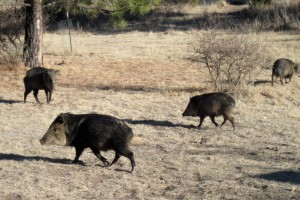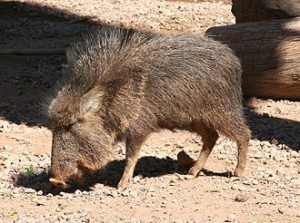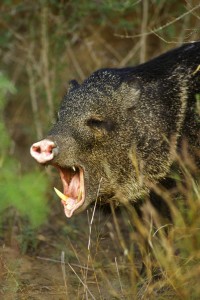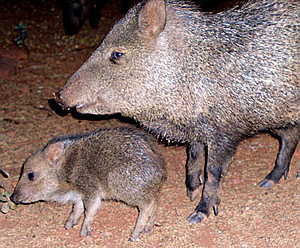 My back yard is open to the desert – no fence. I like it that way. Reminds me that I live in a certain terrain. My house is not an insular platform or barricaded station, but part of an ecology. A family of Javelinas paraded through today. There were about twenty of them, all ages, sizes, and both genders. They weren’t foraging, but marching, definitely going somewhere definite, heading higher into the hills.
My back yard is open to the desert – no fence. I like it that way. Reminds me that I live in a certain terrain. My house is not an insular platform or barricaded station, but part of an ecology. A family of Javelinas paraded through today. There were about twenty of them, all ages, sizes, and both genders. They weren’t foraging, but marching, definitely going somewhere definite, heading higher into the hills.
 Javelinas are like a wild pig, but they’re not a pig. They look like pigs, with the standard piggy snout that looks like an electrical socket. they have cloven hooves, and they say, “Grunt, grunt.” They’re not pink though. They’re covered in spikey brown hair with a lighter-colored stripe draped around their shoulders. The young piglets are smooth, but reddish brown, called “reds,” not “piglets.” Extremely cute.
Javelinas are like a wild pig, but they’re not a pig. They look like pigs, with the standard piggy snout that looks like an electrical socket. they have cloven hooves, and they say, “Grunt, grunt.” They’re not pink though. They’re covered in spikey brown hair with a lighter-colored stripe draped around their shoulders. The young piglets are smooth, but reddish brown, called “reds,” not “piglets.” Extremely cute.
Javelinas are a type of collared peccary, a beast originally from Bolivia and Paraguay, more related to the horse than the pig. You can’t help think of Javelinas as pigs, but you have to remember they’re wild animals. The adults I saw weighed  40 to 60 pounds, maybe more. You wouldn’t want to get between a mom and her red. They have very sharp teeth that stick out of their jaws four inches or more. And they move faster than you can. They can rip all the flesh off your leg before you know what’s happened. Stories of that happening to people around here are common, usually stupid people who try to feed them, but sometimes it’s just someone walking along a Tucson street. Nobody expects to be attacked by a herd of wild pigs on the way to the store.
40 to 60 pounds, maybe more. You wouldn’t want to get between a mom and her red. They have very sharp teeth that stick out of their jaws four inches or more. And they move faster than you can. They can rip all the flesh off your leg before you know what’s happened. Stories of that happening to people around here are common, usually stupid people who try to feed them, but sometimes it’s just someone walking along a Tucson street. Nobody expects to be attacked by a herd of wild pigs on the way to the store.
So I’m watching, from the presumed safety of my patio doorway, a line of javelinas walking past, only 10 yards away. They’re coming from around the side of the house, across my yard, and heading up into the wash. They keep coming as if in an endless line, and it seems like a joke, or a cartoon. Huge boars are in the lead, then some fat mothers, with one or two reds trotting under and around them.  Whenever the mother pauses, the reds immediately race under and jump up to grab a teat, but they can’t hang on and she moves ahead. There’s a five yard space then a few more big males. Are they called bulls or what? Not boars, because they’re technically not a pig. What do you call a huge, male, wild peccary? “Sir,” I would think.
Whenever the mother pauses, the reds immediately race under and jump up to grab a teat, but they can’t hang on and she moves ahead. There’s a five yard space then a few more big males. Are they called bulls or what? Not boars, because they’re technically not a pig. What do you call a huge, male, wild peccary? “Sir,” I would think.
They don’t see me; don’t even look in my direction. They have poor eyesight, but I’m surprised they don’t smell my presence. They may be accustomed to human smells, since obviously they don’t mind living in the dry streambeds between the houses. They must have been breeding and giving birth in the lowlands, where it is even more populated with humans, but maybe where there is more food. They have a thick, leathery mouth, so they can eat prickly pear cactus with no problem, and it’s easy to see evidence of their munching. They’ll also eat carrion, and are quite adept at knocking over 30 gallon trash barrels. I keep mine locked behind a cinder block wall.
More females appear with their frolicking reds. Families are usually about ten individuals, according to the Sonoran Desert Museum, but this is a group of about twenty. “Family” has a loose definition for javalinas. It isn’t a male and his harem. There are six or eight males and maybe four females, each with one or two reds. I’m surprised the males get along. On nature shows, males fight fiercely for females. Nobody wants to share. Javelinas must be very progressive in their social attitudes.
It’s 4:30 in the afternoon, surprising, because most game travels at dusk or dawn. Maybe they were moving by daylight to avoid the coyotes and mountain lions, which tend to be nocturnal. Why was today the particular day for the big hike? “Come on, reds! April 8th, time to move up the mountain. Grunt, grunt! Don’t dally, or the coyotes will get you!” “Oh boy! Let’s go! What’s a coyote?”
 After the line of javelinas had trotted out of sight, I could hear neighborhood dogs farther up the hill barking their heads off, presumably from within the safety of their fenced yards, because if it came down to javelina vs. pet dog, I know which I’d place my money on. Then, when I thought they were all gone, one more javelina appeared in my yard, a huge old grandfather, more gray than the others. I think he was blind, because he couldn’t stay on the path the others had worn in the sand. He zigged and he zagged, but he kept his snout down and always sniffed his way back to the correct direction. If I were a mountain lion, he’d be the one I’d pick off. Or try to.
After the line of javelinas had trotted out of sight, I could hear neighborhood dogs farther up the hill barking their heads off, presumably from within the safety of their fenced yards, because if it came down to javelina vs. pet dog, I know which I’d place my money on. Then, when I thought they were all gone, one more javelina appeared in my yard, a huge old grandfather, more gray than the others. I think he was blind, because he couldn’t stay on the path the others had worn in the sand. He zigged and he zagged, but he kept his snout down and always sniffed his way back to the correct direction. If I were a mountain lion, he’d be the one I’d pick off. Or try to.
I like having wild animals around. The motion-sensing lights around my house come on at night once or twice a week, so I know critters are out there, doing their mysterious things. During the day, I keep my eyes open when I hike in the parks and even when I walk in the neighborhood, and I always carry pepper spray. The most fun is watching animals be themselves, like parading through my yard, on a mission, to who knows where, for who knows what. It’s too bad we can’t communicate with them better.
